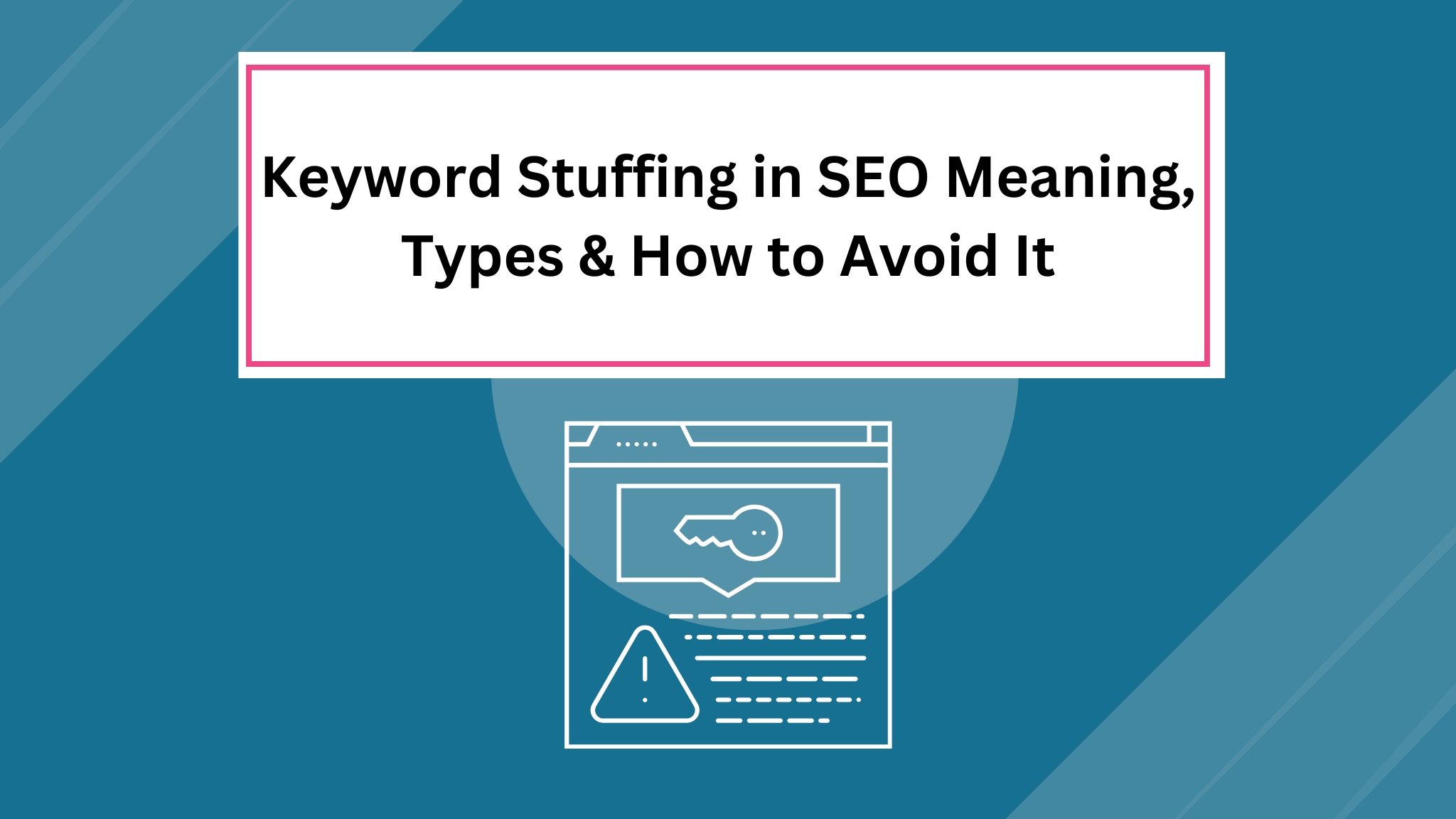Are You Overloading Keywords? Understanding Keyword Stuffing in SEO If you have too many keywords, you might be engaging in keyword stuffing. But what exactly is keyword stuffing? In SEO, it refers to the excessive use of a keyword or phrase in content, often making it less readable and user-friendly.
The logic behind keyword stuffing is simple: if some keywords help with rankings, more must be even better. However, search engines penalize this practice, as it negatively impacts user experience.
Discover more about keyword stuffing in SEO and how to avoid it.
Examples of Keyword Stuffing in SEO
Let’s look at an example of keyword stuffing:
Example:
Keyword stuffing example is a common keyword stuffing mistake. Avoid keyword stuffing in your content because keyword stuffing can lead to penalties.
This paragraph has several issues:
1. Excessive Keyword Density
The phrase “keyword stuffing” appears multiple times, making the content unnatural and spammy. Search engines like Google may penalize such content.
2. Poor User Experience
The text is not written for readers but rather to manipulate search engine rankings. Visitors will find it unnatural and may leave the website quickly.
3. Lack of Content Purpose
There is no logical flow or meaningful information—just an attempt to overuse keywords. This diminishes the content’s value.
Where Keyword Stuffing Can Occur
- Meta Descriptions & Title Tags – Overloading keywords in meta descriptions and titles can make them look unnatural.
- URLs – Stuffing keywords in URLs can appear spammy and reduce credibility.
- Alt Text – Using excessive keywords in image alt text makes it unhelpful for visually impaired users and search engines.
While using keywords is essential for SEO, overusing them unnaturally can hurt your rankings. Focus on meaningful, reader-friendly content instead!
Types of Keyword Stuffing in SEO
Keyword stuffing comes in two main forms:
1. Visible Keyword Stuffing
This occurs when excessive keywords are placed directly within content, making it unnatural and repetitive.
Example:
“Start your day right with aluminum tea pods. These aluminum tea pods make tea preparation quick and effortless. Order aluminum tea pods today for a hassle-free morning!”
In this example, the phrase “aluminum tea pods” is overused, making the content feel forced and spammy.
2. Hidden (Invisible) Keyword Stuffing
This black-hat SEO technique involves adding keywords in ways that aren’t visible to users but can still be detected by search engines. Common tactics include:
- Matching text color with the background
- Placing text behind images
- Positioning text off-screen using CSS
- Using extremely small font sizes
While this method once helped manipulate rankings, search engines now detect and penalize such practices.
For effective SEO, focus on high-quality, user-friendly content rather than keyword manipulation. Want to build a solid SEO strategy? Start learning today.
The Risks of Keyword Stuffing in SEO
Keyword stuffing not only disrupts the user experience but also violates search engine guidelines. Google identifies it as low-quality content and has introduced several updates to combat this practice.
Major Google Updates Targeting Keyword Stuffing
1. Panda Update (2011)
Google’s first major algorithm update to penalize keyword stuffing. Websites detected using this tactic saw a drop in rankings or complete removal from search results.
2. Hummingbird Update (2013)
This update improved Google’s ability to understand natural language, focusing on context rather than individual keywords. Websites relying on keyword stuffing lost their rankings.
3. BERT Update (2019)
BERT introduced a better understanding of word relationships and nuances, favoring well-structured, meaningful content over keyword-packed text.
4. Vicinity Update (2021)
Designed for local search, this update reduced the impact of excessive keyword usage in business listings. Many keyword-stuffed listings saw ranking drops.
Consequences of Keyword Stuffing
If Google detects keyword stuffing on your site, you may face:
- A warning email – A notification about guideline violations.
- Partial suspension – Your listing remains visible but cannot be edited.
- Hard suspension – The listing is removed from Google entirely, including all reviews and photos.
To maintain search visibility and rankings, focus on high-quality, user-friendly content rather than keyword manipulation.
How Keyword Stuffing Impacts SEO
Keyword stuffing is a black-hat SEO tactic that can significantly harm a website’s search rankings. When search engines crawl a website, they analyze content to determine its relevance for specific keywords. However, if keywords are overused unnaturally, search engines recognize it as keyword stuffing and penalize the site.
Negative Effects of Keyword Stuffing on SEO
1. Lower Search Visibility When a website is penalized for keyword stuffing, it struggles to rank on the first page of search results, reducing its discoverability and organic traffic.
2. Loss of Credibility A penalized website may appear untrustworthy to users. Visitors who recognize excessive keyword usage may perceive the content as spammy and unreliable, reducing engagement.
3. Poor User Experience Keyword-stuffed content is often unreadable and lacks relevance. Users may find it difficult to understand, leading to high bounce rates and lower dwell time—both of which signal to search engines that the content lacks value.
The Right SEO Approach
Instead of keyword stuffing, website owners should:
- Focus on high-quality, informative, and engaging content.
- Use natural keyword integration with synonyms and variations.
- Keep keyword density between 2-3% of the total content.
- Leverage other SEO strategies like link building and optimized meta tags.
By prioritizing user experience and content quality, websites can achieve sustainable SEO success without the risk of penalties.
Why Keyword Stuffing is Harmful to SEO
Keyword stuffing negatively impacts SEO by reducing content quality and making it appear spammy. Overusing keywords disrupts readability, discourages user engagement, and damages a brand’s credibility. Additionally, it prevents pages from ranking well on search engines.
How Keyword Stuffing Harms Your Website
1. Violates Google’s Guidelines Google’s spam policies strictly prohibit keyword stuffing. If Google detects excessive keyword use in on-site content or backlinks with overly optimized anchor text, the site may face:
- Lower rankings
- Search penalties
- Complete removal from Google’s search index
2. Poor User Experience Keyword stuffing results in repetitive, unnatural content that readers find difficult to engage with. Visitors are more likely to leave a site quickly, increasing bounce rates and decreasing credibility.
3. Ineffective in the Long Run While some webmasters attempt black-hat SEO tactics, search engines continuously update their algorithms to penalize spammy strategies. Over time, websites relying on keyword stuffing will struggle to maintain visibility.
The Better Approach
Instead of stuffing keywords, focus on:
- Creating high-quality, valuable content.
- Using natural language and keyword variations.
- Prioritizing user experience to keep visitors engaged.
By following ethical SEO practices, websites can achieve long-term success without risking penalties.
Why Do Websites Use Keyword Stuffing?
Websites resort to keyword stuffing in an outdated attempt to boost SEO rankings. In the past, search engines ranked pages higher if they contained frequent keyword repetitions and keyword-rich backlinks. This led many site owners to overuse keywords, hoping to manipulate rankings.
Why This No Longer Works
Google has since launched multiple algorithm updates to combat keyword stuffing:
- Context-Based Ranking – Google now prioritizes content quality, search intent, and comprehensiveness over keyword frequency.
- Advanced Spam Detection – Google’s web spam detection systems can easily identify and penalize keyword stuffing.
- User Experience Focus – Pages overloaded with keywords no longer rank well, as they offer little value to readers.
The Right SEO Strategy
Instead of keyword stuffing, websites should focus on:
- Creating informative and engaging content.
- Using keywords naturally within the text.
- Understanding search intent to improve content relevance.
Want to improve your SEO skills? Learn from industry experts and stay ahead in the digital landscape.
How to Identify Keyword Stuffing?
To detect keyword stuffing, analyze your web pages for keyword density and compare it to the recommended 1-3% range. If a keyword appears excessively, it may negatively impact SEO.
Ways to Identify Keyword Stuffing:
- Use SEO Tools – Keyword research tools help check keyword difficulty and competition levels.
- Check for Plagiarism – Duplicate or copied content may indicate keyword spamming.
- Read for Natural Flow – Content should sound engaging, informative, and natural, not forced or repetitive.
How to Avoid Keyword Stuffing?
Website owners sometimes use keyword stuffing as a shortcut for ranking higher, but this tactic harms SEO in the long run.
1. Conduct Thorough Keyword Research
- Analyze market trends and keyword difficulty.
- Consider factors like Domain Authority, Page Authority, and website trustworthiness to determine ranking potential.
2. Increase Word Count
- Expanding content allows for organic keyword distribution rather than forced repetition.
- Helps maintain readability and improves user experience.
3. Monitor Keyword Density
- Ideal keyword density should stay below 2%.
- Use Keyword Density Checker tools to ensure natural content flow.
4. Assign a Primary Keyword Per Page
- Choose a low-competition keyword relevant to the content.
- Avoid targeting the same keyword across multiple pages.
5. Optimize Keywords for On-Page SEO
Proper keyword placement improves SEO without overstuffing. Insert keywords in:
- Title Tag
- Meta Description
- Image Alt Tags
- First Paragraph
- Page Title
FAQs on Keyword Stuffing in SEO
1. How often can I use a keyword before it’s considered stuffing?
There’s no exact limit, but keywords should be used naturally. Overuse can make content sound forced and spammy. Use secondary keywords and variations to maintain readability.
2. How does Google penalize keyword stuffing?
Google’s Spam Policies flag excessive keyword usage. Consequences include:
Algorithmic Downgrade – The page drops in rankings.
Manual Penalty – Google may remove the page from search results.
3. Is keyword stuffing a ranking factor?
No. Search engines now prioritize content quality over keyword frequency. Instead of boosting rankings, keyword stuffing is considered a spam signal and can hurt SEO performance.
Conclusion
Keyword stuffing is an outdated and ineffective SEO strategy. It doesn’t just violate Google’s guidelines it also harms user experience, credibility, and search rankings. A keyword-stuffed page loses audience trust, visibility, and long-term SEO potential.
Rather than trying to manipulate search engines, focus on creating high-quality, informative, and user-centric content. Prioritize natural keyword integration and user intent to build a strong, sustainable SEO strategy that benefits both search engines and readers.




